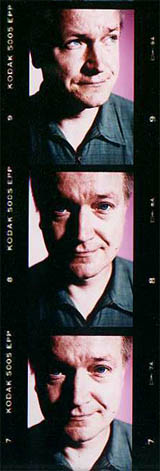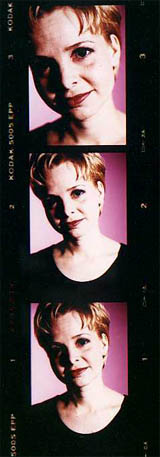Michal Shapiro talks to Kirsi Kähkönen and Kari Reiman
On a broiling Sunday in July, the Finnish band Värttinä took possession of Central Park Summerstage and wowed a crowd of sweat-drenched New Yorkers who sat through a diverse program which included crossover throat-singing and quasi-ambient Celtic music. Between acts, hoses were set up to spray those who were dehydrated and hopelessly hot. But people stayed on for Värttinä, and the band did not disappoint. They pounded out a set filled with high-powered vocals, masterful playing and memorable songs crafted from Finnish folk music but bearing the band's own stamp of originality.

 Two days before, at a reception at the Finnish Consulate, I talked with Kirsi Kähkönen, representing the vocal side of the band and violinist Kari Reiman, representing the instrumental side, and what emerged was an enviable pattern of artistic forward movement.
Two days before, at a reception at the Finnish Consulate, I talked with Kirsi Kähkönen, representing the vocal side of the band and violinist Kari Reiman, representing the instrumental side, and what emerged was an enviable pattern of artistic forward movement.
The band started out in 1983, in a small village called Rääkkylä, in the southeastern part of Finland. "In the beginning it was just a hobby for us," Kirsi said. "We were ages 10-16. We had 21 members, from '83-'89. It was not exactly a folk club, we would read Karelian poems, and then we started to add some music, and it became more and more music, and nowadays there are no poems any more. In 1989 we split up because Rääkkwlä was just a small town, and we had to go to other cities to go to school. "
"And then the band was reincarnated," Kari added. "Sari (Kaasinen) found out that five of the original members were moving to Helsinki, so she started to gather people together. What was different about the sound that we put together was that up until that time, when people played or listened to these Karelian songs, there was always a very soft accompaniment, most of the time with kantele. But the sound that we played on Oi Dai was very aggressive, and there was a very strong woman's point of view in the lyrics, and that was quite different and strange for Finns. "
When and why did the band start to fuse original and traditional melodies?
"On Oi Dai all the songs were traditional," answered Kari, "but on Seleniko, maybe half of the songs were. Since that time, it's more and more composed material. But it's a process that we started with Oi Dai. With the Finno-Ugric singing style, which is the basis of what we do, the songs are very short, they have only one or two bars of music, so it's hard to make a modern sounding song of them. What we did was to combine many traditional songs into medleys. Sometimes we would play one song as an instrumental, to break up the medley, and then bring back another, different song for the next part. But it's actually quite difficult to do that, because it's hard to find a good melody, and then to find another traditional one that will suit the other, and fit together nicely. So eventually, instead of finding traditional songs, we started writing tunes that would serve the same purpose. That was the first stage, and then we said, why not do the whole song this way. "
"Almost everybody writes now," mentioned Kirsi. "We already have enough material for a new CD, we just have to find the time to finish it all. Everybody is writing. "
"Working up arrangements is the most exciting thing in this band," added Reiman, "because nobody knows how a tune will sound when somebody comes with the melody. We just start to improvise, and then we record. We have a little recorder, just like yours, exact same model! We record and then we try another approach. Which means that the bass player and the drummer take it a different tempo or a different feeling. Then we listen, and we have lots of choices. And then we decide on the approach, and then we write the structure. Maybe its A-B, or A-B-C, and we write it out. The arranging process is very long. If some one person did all the arranging, it would be very fast, but we have tried that a few times and the results are not good--its not the same band any more, because the mixture of everybody's ideas is Värttinä's style. "

 Vihma is certainly a new and exciting direction for the band, inasmuch as it gave them the opportunity to work with producer Richard Horowitz. The collaboration yielded a CD with different timbres, one that most people agree puts the band more firmly into the mainstream.
Vihma is certainly a new and exciting direction for the band, inasmuch as it gave them the opportunity to work with producer Richard Horowitz. The collaboration yielded a CD with different timbres, one that most people agree puts the band more firmly into the mainstream.
Vihma was already recorded when he started working with us. " explained Kari. "But it was great to have somebody really new come in, because the whole atmosphere in the studio became very creative, very relaxing. " interjected Kirsi "He didn't tell us exactly what to do, he just suggested things he would like to hear, so one by one we went into the studio and experimented with our singing. We had two days to record our improvisations, and he picked out the things that he liked. Because Värttinä's style is very staccato with very loud vocals all the time, what Richard wanted was to have some soft voices and longer notes. "
"And I think that many things just happened when he suggested the idea. " mused Kari "We had been thinking of the same things ourselves. But we needed someone to tell us, and that was when we all felt free to start following these ideas. I'm really happy about Vihma. Of course looking way back, now I would liked to have done things differently. When I listen to Seleniko, I would have liked to have had more dynamics, and to re-record some things. Now we perform updated, reworked arrangements for things from older recordings. .
"I think the band is stronger, because each person has been doing so much," said Kirsi, "I have been starting to write words, and Mari has been starting to write melodies, and so we are finding a lot of new energy and encouragement amongst ourselves. "
"It's like a family, we've been together for such a long time, we have found a good balance," said Kari.
"Yes it's a family," winked Kirsi, "with lots of boys!"
From the moment the four female lead singers walked on to the Summerstage with microphone headsets, all went as smoothly as clockwork. Harmonies were tight, movements were carefully choreographed, the band played through the complex charts flawlessly, and the two soundmen who travel with the band made sure that the mix was on target. After an electrifying show that had the audience to its feet, Kirsi Kähkönen said "Thank you," and I heard a young man exclaim while applauding, "No, Thank YOU!" - Michal Shapiro
Read reviews of all of Värttinä's recordings